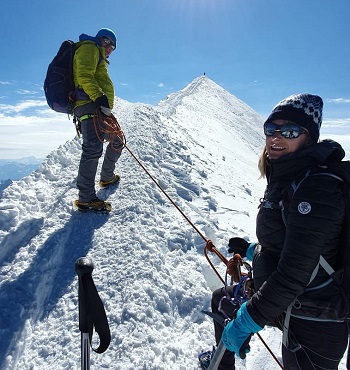

NOW BOOKING FOR 2026 SEASON. Mont Blanc was the birthplace of Alpinism when it was first climbed in 1786 by Jaques Balmat and Doctor Paccard. Their ascent showed what was possible and continues to inspire people. To this day it is still a huge lure attracting people from all over the world. The two main reasons for not reaching the summit are poor weather and lack of fitness. We can't do much about the weather, but you should make sure you're fit ! See later for more info on fitness.
After three days of preparatory climbs and acclimatisation we’ll head up for our summit attempt. The Gouter (aka Arete des Bosses) route gives the best chance of success on the mountain as it is the easiest to climb after snowy weather. We always allow three full days for the summit attempt to give maximum flexibility in case of bad weather and the best chance of getting to the top. This tactic has given us one of the best success rates of any operators on the mountain.
The ascent of Mont Blanc is not a walk ! This common misconception has caused a few issues over the years, and anyone considering Mont Blanc should be aware that a standard ascent involves the following:
2 1/2 hour walk from the Nid'Aigle railway station to the Refuge Tete Rouse. This is often snow-free, but early and late season the paths may be snowy. They are also quite exposed in places. If snowy and icy you may rope-up for one section of the path (1 hour max).
Tete Rousse to summit. Breakfast will usually be taken around 4:30, but if the weather or conditions dictate, an early breakfast at 01:30 may be necessary. After leaving the Tete Rousse we begin with an easy ascent on snowy/rocky paths for 20 minutes. We are normally roped-up on this, but this is only because of the more serious ground to follow. On reaching the Grand Couloir the Guide will make a judgement about whether it is safe to cross. Sometimes stonefall prevents us from going any further. If the Guide is happy then we quickly head across the 50m wide couloir. Once on the other side we scramble up steep tracks, occasionally using in-situ cables, sometimes on snow, and often using our hands. From the Tete Rousse Refuge to the Gouter Refuge takes 2 - 2 1/2 hours. Once at the Gouter we usually take a break in the warmth of the boot room.
From the Gouter to the summit takes 3-4 hours. The terrain begins as a fairly gentle glacial slope. 2 hours after starting we usually stop at the Vallot Bivouac for a break. From there the terrain becomes much steeper and more serious, with an often exposed ridge of snow finally leading to the broad summit. And after all that you then have to come back down ! The descent to the Refuge Gouter takes around 2 hours and we will then stay there for the night to allow us to cross the Grand Couloir in the early morning when the risk of stonefall is lowest. The whole day can easily be 10 hours and is not to be under-estimated.
Descent from the Gouter Refuge to the Ni d'Aigle station takes 3-4 hours.
If the weather is not looking ideal for our proposed summit day we sometimes use the middle day to climb to the Gouter Refuge, before then getting an early start the next day to reach the summit and descend back to the valley before the Grand Couloir becomes too active.
Having personally climbed Mont Blanc well over 35 times I have tried numerous different tactics to maximise the chance of success. This programme is the result - you have two realistic chances of reaching the summit after a proper period of acclimatisation and training. Now all you have to do is make sure that you're fit enough and motivated when you arrive !
NB: From 2022 all reservations in refuges on Mont Blanc require photo ID at the booking stage. This is to prevent "speculative bookings" which for many years made it very hard to get reservations. Before booking your space on a trip you must contact me to confirm that a refuge reservation is likely. After booking via this website you will be required to submit a copy to me of either your Driving License or Passport, in a JPEG or PDF format, in low res <1MB. Driving License is preferred. DUE TO DEMAND, THE FURTHER IN ADVANCE THAT YOU BOOK, THE BETTER THE CHANCES OF GETTING THE BEDS AT THE REFUGES. WE STRONGLY RECOMMEND BOOKING A YEAR IN ADVANCE.
Included:
6 days of Professional Mountain Guiding
Accommodation in Chamonix Valley (3 nights Half Board).
All Mountain Refuges for you and your Guide(s) (4 nights Half Board)
Trip planning and Refuge reservations
Safety equipment (carried by Guide)
Local transportation (within the course programme)
Not included:
Travel to Chamonix Valley
Insurance
Equipment Hire (you can rent most equipment from us, and boots can be hired locally)
Lift Fees
| From | To | Price (Euros) | Places Available | Book |
| 04 Jun 2026 | 11 Jun 2026 | 3300 | 0 | Course fully booked |
| 11 Jun 2026 | 18 Jun 2026 | 3300 | 1 | Book a place |
| 17 Sep 2026 | 24 Sep 2026 | 3300 | 2 | Book a place |
| 03 Jun 2027 | 10 Jun 2027 | 3460 | 8 | Book a place |
| 10 Jun 2027 | 17 Jun 2027 | 3460 | 8 | Book a place |
| 16 Sep 2027 | 23 Sep 2027 | 3460 | 8 | Book a place |
